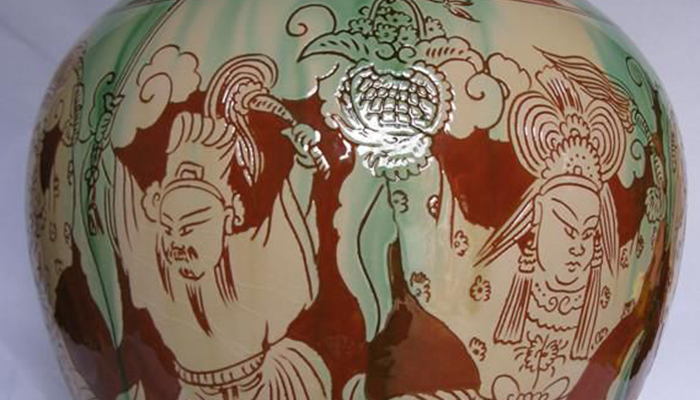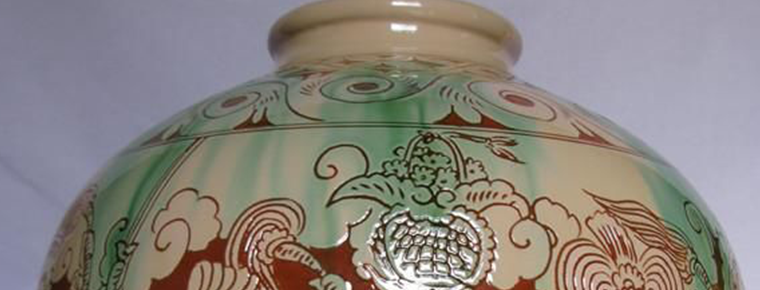Firing Techniques of Jieshou Coloured Pottery
Firing Techniques of Jieshou Coloured Pottery
The firing technique of Jieshou colored pottery, the local traditional handicraft technique of Jieshou City, Anhui Province, is one of the national intangible cultural heritages.
The firing skills of Jieshou painted pottery originated from the Tang Dynasty, and is the essence of handicrafts in Huaibei. In 1999, the Liuzi Canal in Huaibei unearthed a large number of first three-color pottery pieces, which became one of the ten archaeological discoveries in China at that time.
On May 20, 2006, the firing technique of Jieshou color pottery was approved by the State Council and listed in the first batch of national intangible cultural heritage list. On May 15, 2018, it was selected as the first national catalogue of revitalization of traditional crafts.
historical origin
In the Sui Dynasty, Jieshou had a history of burning pottery in vertical kilns.
In the Tang Dynasty, the first three-color carved pottery came into being because it was next to Luoyang, the origin of the three-color pottery in the Tang Dynasty.
After nearly a thousand years of development, the first three-color carved pottery has gradually evolved into today's three-color carved pottery. However, its unique plastic arts and decorative arts still maintain the ancient charm.
Process characteristics
Feature summary
The ancestors of the Tang Dynasty used the external force of their feet to make the pottery wheel rotate at a uniform speed, put mud on the wheel, put their hands on it skillfully, and pull out the pottery tires with ever-changing shapes. After drying, white clay was applied to the tread, then dried to half-dry, painted flowers, birds, fish and insects on the tread with iron or bamboo sticks, then glazed with lead and earth, dried and placed in the kiln, and firewood fired for three or four days. Its depiction content, mostly natural flowers and birds, and because its jar neck or bottom are engraved with two consecutive patterns of flowers as the theme, so it is called carved pottery; pottery kiln burned ochre red, with emerald green and earth yellow glaze, natural formation of tricolor glaze, the combination of the two is called tricolor carved pottery.
From the second period, after hundreds of years of practice, pottery artists gradually enriched the depiction theme of colored pottery. Besides flowers, birds, fish and insects, traditional dramatic scenes such as "Breaking Hongzhou", "Battling Qinqiong", "Haze Beauty Case" and so on also "moved" to the pottery altar; in the performance techniques, the use of picking, carving, scraping and other techniques, make the picture more colorful, and the theme more distinct. The decorative techniques of painted pottery in this period have continued to this day. Its decorative techniques are mainly manifested in two aspects: one is the particularity of the tool. Using knives and needles instead of pens, cutting, engraving and scraping together, the picture produces black, white and grey artistic effects; this traditional technique is no exception in China's domestic ceramics industry. Second, the compatibility of regional folk art. The decorative artistic features of Jieshou painted pottery not only include the lines of local woodcut New Year pictures, but also absorb the characteristics of the combination of lines and surfaces of Jieshou paper-cut.
Decorative elements
The unique art of decoration of painted pottery is composed of many elements. Such as the unconscious application of the gold rate, the processing of space, the layout of the picture and so on, the best combination of its multiple elements creates the unique artistic personality of Jieshou painted pottery. However, Jieshou painted pottery is the crystallization of human being's continuous observation, discovery, refinement and creation in the long-term production practice and social life; from simple imitation to comprehensive artistic creation, from occasional discovery to skilled mastery, so repeated practice, inspiration and regularity, the principle of creating beauty is summed up. Therefore, the symmetrical, balanced and decorative beauty of Jieshou painted pottery is a collection of beauty rooted in local life. The main material of Jieshou painted pottery comes from the clay layer on both sides of Yinghe River. Therefore, it has the local and national characteristics, thus forming the "Jieshou painted pottery" with personality and unique artistic language.
Modeling law
Inheritance and protection
Inheritance significance
The firing technique of Jieshou painted pottery reflects the peasants'honest and simple character and the aesthetic interest of their clumsiness and ingenuity. It also reflects the aesthetic trend of Chinese folk art that advocates nature and pursues harmony.
representative figure
Lu Qunshan, male, born in September 1950. In June 2007, Lu Qunshan was selected as the representative successor of the first batch of national intangible cultural heritage projects and declared by Jieshou City, Anhui Province.
Wang Jingsheng, male, Han nationality, born in 1944, is from Jieshou City, Anhui Province. In June 2007, Wang Jingsheng was selected as the representative successor of the first batch of national intangible cultural heritage projects and declared by Jieshou City, Anhui Province.
protective measures
On the afternoon of August 1, 2017, Anhui Provincial Non-Heritage Center, Fuyang City Non-Heritage Center and Jieshou Municipal New Bureau of Culture and Guangzhou held the docking meeting of the national representative inheritors of intangible cultural heritage.
The National Representative Inheritant Recording Project of intangible cultural heritage is a comprehensive and complete project initiated by the Ministry of Culture to record the rich knowledge and exquisite skills mastered by the national representative inheritors. It is of great significance to preserve the intangible heritage materials, promote the inheritance of intangible heritage, and accelerate the research and protection of intangible heritage.
social influence
Honorary commendation
From August 8 to August 13, 2013, in the 8th China Folk Art Exposition co-sponsored by the Chinese Federation of Literature and Artists, the Chinese Association of Folk Literature and Artists, the People's Government of Jilin Province and the People's Government of Changchun City, Lu Lihua, the provincial representative inheritor of the "world's first colorful pottery firing skills", won the silver prize for folk art works.
Important exhibition
On June 30, 2017, Huayun Anhui Non-Heritage Hall, located at 77 Qianmen Street, Beijing, was officially opened, among which the first painted pottery in the world was one of its exhibits.
On October 10, 2014, the 3rd China intangible cultural heritage exposition was held in the ShunGeng International Convention and Exhibition Center of Jinan, among which the first painted pottery in the world was one of the exhibits.
Cultural anecdotes
At first, the Lujia only burned black pottery to produce some daily necessities. One year, Li Yuan, the father of Li Shimin, Taizong of Tang Dynasty, passed through the Liuli Temple of Jieshou, and lived nearby. He dreamed of Litai at night. There were green, yellow and white pottery pots on it. When he woke up, he immediately ordered the nearby potters to make three-color pottery. However, due to the limited skill of the kiln-maker at that time, he burned for three days and three nights, only burned yellow and white pottery pots, and could not think of a way to make green pottery.
Just when everyone was worried, a copper worker passed the kiln factory. Because of continuous rains for many days, the copper worker was forced to work in the kiln factory. Some copper powder was blown into the kiln by the wind. Unexpectedly, these copper powder changed the color of the pottery and they produced green pottery. Lu Qunshan said that up to now, copper powder is still one of their raw materials for making pottery. When the Lu family mastered the skills of making tricolor pottery, it began to pass on from generation to generation and spread gradually.


-
1.Sliced Fish in Hot Chili Oil
Boiled fish, also known as river boiled boiled fish and boiled fish fillet, was first popular in Cui Yun Township, Yubei District, Chongqing.
Time 2018-10-27 -
2.Shanghai Museum
The Shanghai Museum was founded in 1952. It was originally located at the Old Jockey Club at 325 Nanjing West Road. It moved to the Zhonghui Building at 16 Henan South Road in October 1959
Time 2018-12-19 -
3.Guanyin Mountain National Forest Park Guangdong
Guanyinshan National Forest Park in Guangdong Province is the first National Forest Park in Dongguan City approved by the State Forestry Administration. It is located in Zhangmu Town, Dongguan City
Time 2019-01-13 -
4.jianchuan museum cluster
Jianchuan Museum is called Jianchuan Museum Settlement in Chengdu City. Founded by private entrepreneur Fan Jianchuan, it is located in Anren Town, Dayi County, a small museum town of China
Time 2019-01-21 -
5.Qianling Mountain Park
Qianling Mountain Park is a comprehensive tourist park, built in 1957, located in the northwest corner of Guiyang City. It is named Qianling Mountain because of its "first mountain in southern Gu
Time 2019-02-07 -
6.Legend of White Horse Dragging
The legend of white horse dragging rein is spread in Baima Temple in Jincheng, Shanxi Province. Baima Temple Mountain was originally named Sima Mountain
Time 2019-04-03 -
7.Cloth paste painting
Teng Teng is the founder of Teng's cloth paste painting. He was born in Fengning Manchu Autonomous County, Hebei Province in 1932. He is the director of Teng's cloth paste painting
Time 2019-04-04 -
8.Haha Opera
Haha Opera, also known as Liuzi Opera and Drinking Opera, is a local opera originated from the folk in Hebei Province. It is the first national intangible cultural heritage
Time 2019-05-02 -
9.Glass Firing Techniques
Glass firing technology, Beijing Mentougou District, Shanxi Province, local traditional handicraft, one of the national intangible cultural heritage.
Time 2019-05-14 -
10.The Miao costumes
Miao is an international ethnic group originating from China. In the 2010 census, Miao is mainly distributed in Guizhou, Hunan, Yunnan, Chongqing, Hubei, Sichuan, Hainan, Guangxi and other provinces (
Time 2019-06-05 -
11.Qinghai Lower String
Qinghai Xixian, which originated in the late Qing Dynasty, is one of the traditional folk arts native to Qinghai. It is a sitting and singing art, singing alone or in pairs.
Time 2019-06-11 -
12.Qingming Festival
Qingming Festival, also known as Taqing Festival, Xingqing Festival, March Festival, ancestor worship festival, the festival period in mid-spring and late spring. Qingming Festival originated from anc
Time 2019-06-11